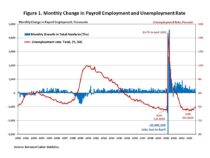Job growth decelerated in October. Total nonfarm payroll employment increased by 150,000 and the unemployment rate edged up to 3.9% in October from 3.8%. The labor market is cooling. The Fed held interest rates steady for the second meeting in a row at the conclusion of its November meeting. This month’s employment data will be one of the key components in determining whether to hold the federal funds rate again at its December meeting. Given the cooling data, the bond market has seen a decline in interest rates, with the 10-year Treasury rate falling below 4.6% to a near two-month low.
Additionally, wage growth continued to slow. In October, wages grew at a 4.1% year-over-year (YOY) growth rate, down 0.8 percentage points from a year ago. It marks the lowest YOY wage gain since June 2021, suggesting inflationary pressures are easing.

Total nonfarm payroll employment increased by 150,000 in October, following a gain of 297,000 in September, as reported in the Employment Situation Summary. In addition to the October slowdown, the estimates for the previous two months were revised lower. The estimate for August was revised down by 62,000 from +227,000 to +165,000, while the September increase was revised down by 39,000, from +336,000 to +297,000. Combined, the revisions took the original estimates down by 101,000.
Despite restrictive monetary policy, about 5.9 million jobs have been created since March 2022, when the Fed enacted the first interest rate hike of this cycle. In the first ten months of 2023, nearly 2.4 million jobs were created, and monthly employment growth averaged 239,000 per month, less than the average monthly growth of 399,000 in 2022.
The unemployment rate rose to 3.9% in October. The number of unemployed changed little, at 6.5 million, while the number of employed persons decreased by 348,000.
Meanwhile, the labor force participation rate, the proportion of the population either looking for a job or already holding a job, decreased 0.1 percentage point to 62.7%. Moreover, the labor force participation rate for people who aged between 25 and 54 edged down to 83.3%. While the overall labor force participation rate is still below its pre-pandemic levels at the beginning of 2020, the rate for people who aged between 25 and 54 exceeds the pre-pandemic level of 83.1%.

For industry sectors, employment in health care (+58,000), government (+51,000), social assistance (+19,000), and construction (+23,000) increased. Employment in manufacturing declined by 35,000. It reflects a decline of 33,000 in motor vehicles and parts that was mostly due to the auto strikes.
Employment in the overall construction sector increased by 23,000 in October, following a 13,000 gain in September. While residential construction added 13,700 jobs, non-residential construction employment added 8,400 jobs for the month.
Residential construction employment now stands at 3.3 million in October, broken down as 936,000 builders and 2.4 million residential specialty trade contractors. The 6-month moving average of job gains for residential construction was 8,367 a month. Over the last 12 months, home builders and remodelers added 55,600 jobs on a net basis. Since the low point following the Great Recession, residential construction has gained 1,325,900 positions.
In October, the unemployment rate for construction workers was unchanged, at 5.1% on a seasonally adjusted basis. The unemployment rate for construction workers remained at a relatively lower level, after reaching 14.2% in April 2020, due to the housing demand impact of the COVID-19 pandemic.

Discover more from Eye On Housing
Subscribe to get the latest posts to your email.


As job growth slows in October, the impact on interest rates comes into focus. For individuals considering construction projects, this could present a favorable window. Exploring construction loans during this period may offer advantageous terms for those looking to embark on building ventures amidst the evolving economic landscape.